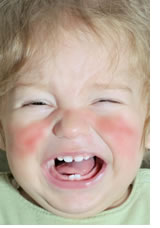
 Slapped Cheek Syndrome
Slapped Cheek Syndrome…what the?
If you've received a note from child care or school recently saying that Slapped Cheek syndrome is rife, your initial reaction may well have been to wonder if it was one of these ridiculous mobile phone fads where kids record themselves slapping another kid round the face (that's called happy slapping)… However it's not. Actually it's a pretty common, but very contagious virus mainly suffered by children and is also known as slapped cheek syndrome, slap cheek, slap face or slapped face.
According to Wikipedia, Slap Cheek Syndrome (aka Erythema infectiosum or fifth disease) is so called due to the bright red cheeks that are a defining symptom of the infection in children (hence the name "slapped cheek disease").
Occasionally the rash will extend over the bridge of the nose or around the mouth. In addition to red cheeks, children often develop a red, lacy rash on the rest of the body, with the upper arms and legs being the most common locations. The rash typically lasts a couple of days and may itch; some cases have been known to last for several weeks. Patients are usually no longer infectious once the rash has appeared.
Teenagers and adults may present with a self-limited arthritis. It manifests in painful swelling of the joints that feels similar to arthritis. Older children and adults with fifth disease may have difficulty in walking and in bending joints such as wrists, knees, ankles, fingers, and shoulders.
The disease is usually mild, but in certain risk groups it can have serious consequences:
Those mainly affected:
- Pre- school and school age children
- Mothers of small children
- Care workers and teachers
- Pregnant women - infection in the first trimester has been linked to hydrops fetalis, causing spontaneous miscarriage and so women who are pregnant and exposed to the disease should see a doctor for a blood test as quickly as possible
- People with sickle-cell disease or other forms of chronic hemolytic anemia such as hereditary spherocytosis. Infection can precipitate an aplastic crisis
- Immuno-compromised (e.g. people with HIV/AIDS and patients undergoing chemotherapy) may be at risk for complications if exposed.
© 2012 - All rights reserved
Care For Kids Internet Services Pty Ltd
ABN 55 104 145 735
PO Box 543 Balmain NSW 2041
privacy policy contact us